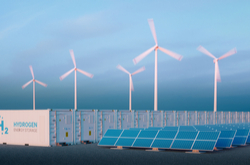Emissions-free hydrogen production edges closer with new pilot site in Denmark
With increased efforts to cut carbon emissions, electric power from renewables has emerged as a vital energy source. Thanks to its strong potential to support energy transition, the role of hydrogen as a versatile, clean and safe energy carrier is widely recognised. Its production based on wind power utilising electrolysis – the separation of water into hydrogen and oxygen – is a known technology. However, cost-competitive and sustainable production of large amounts of hydrogen with this process has proven difficult. The EU-funded HyBalance project is tackling this challenge by producing hydrogen on a larger scale from wind turbines with a power-to-hydrogen plant. It will enable the storage of cheap renewable electricity, providing both grid balancing services and hydrogen for industrial users. It will also supply the transportation sector with hydrogen. The project’s pilot site was recently inaugurated by Air Liquide, the company that is coordinating HyBalance. As explained in a press release, the electrolyser, “with a capacity of 1.2 MW, enables the production of around 500 kg of hydrogen a day without releasing CO2.” This will be enough for 1 000 cars and can also be supplied to hydrogen buses and forklifts, according to a presentation on the project website. Besides industrial customers, the hydrogen that’s produced is used to supply the network of five hydrogen stations installed and operated in Denmark. Balance and stability Grid balancing is crucial for the stability of electricity systems. Due to their intermittent nature, solar or wind energy sources can over or undersupply a grid with electricity. If left unbalanced, the excess voltage and frequency from the oversupply of electricity could cause damage to electronics. Electrolysers enable utility companies to store the energy that would be wasted over long periods of oversupply. During peak demand, the stored hydrogen can be used to generate enough electricity. “Wind power is fluctuating and requires adequate flexibility options to ensure balance in the electricity grid. Dynamic water electrolysis offers such flexibility using electricity when the prices are low or there is a need for balancing and transforming it into hydrogen,” a project brochure notes. In its bid to promote green transition, “HyBalance will develop business models which will determine when it pays off to turn the wind power into hydrogen,” as highlighted in the same presentation. The project will use proton exchange membrane (PEM) electrolysis technology, which is characterised by high efficiency (more hydrogen produced per kWh of electricity) and flexibility, according to the presentation. The partners hope that this technology will be fully validated for commercial applications when the project is concluded. The ongoing HyBalance (HyBalance) project was designed to demonstrate the link between energy storage in the form of hydrogen and the deployment of hydrogen mobility solutions. “It will not only validate highly dynamic PEM electrolysis technology and innovative hydrogen delivery processes involved but also demonstrate these in a real industrial environment by applying high pressure hydrogen production and delivery equipment,” as stated on CORDIS. For more information, please see: HyBalance project website
Countries
France



